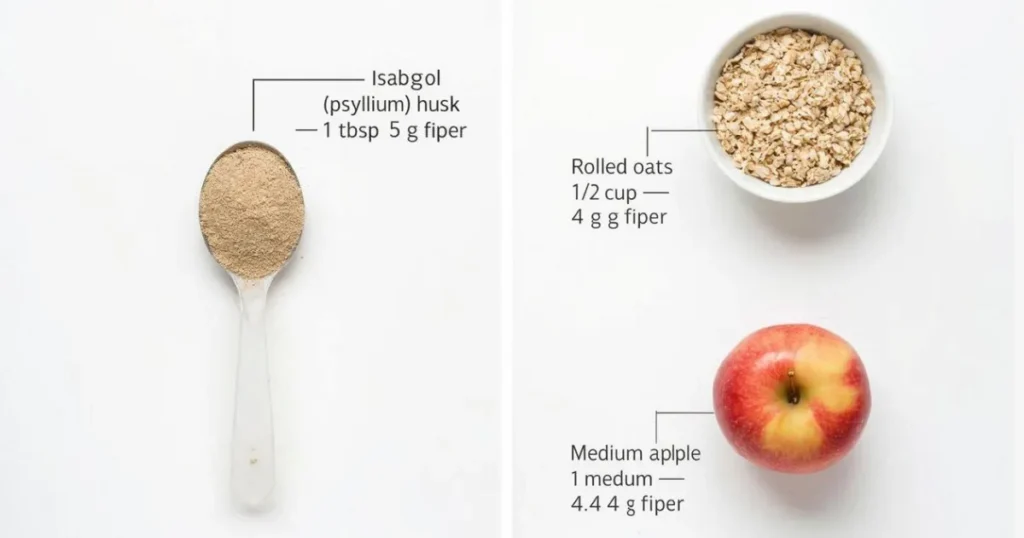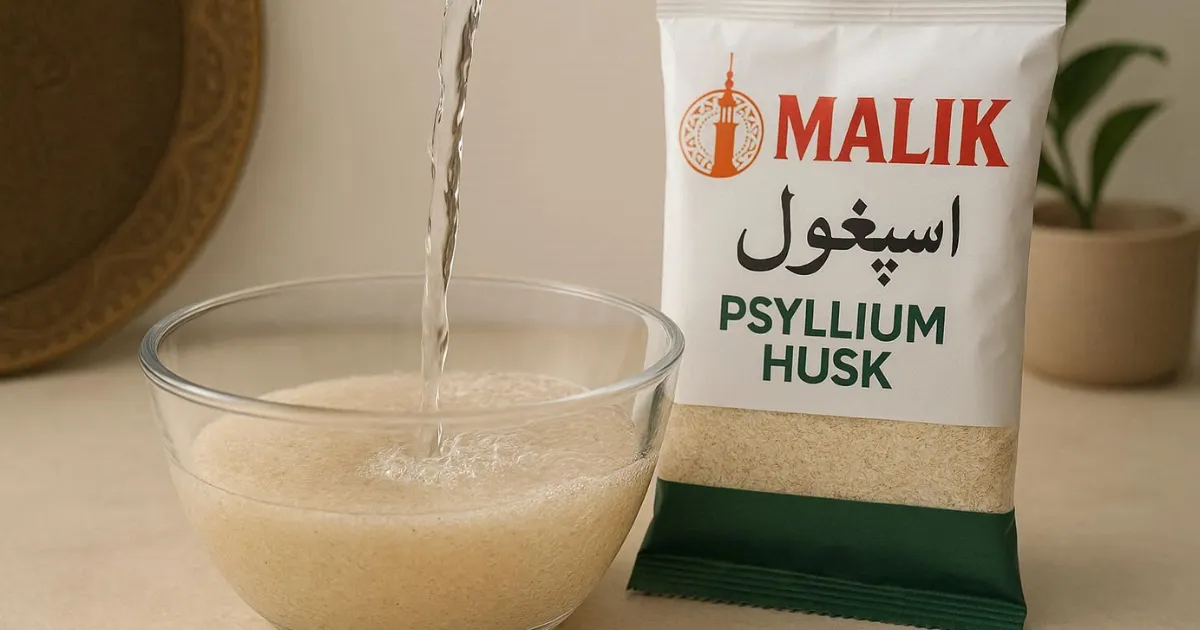Isabgol (Ispaghol): Fiber, Benefits, Recipes, and Daily Use Explained

If you’ve ever struggled with digestive issues, weight management, or wanted to add more natural fiber to your diet, you’ve probably heard about isabgol. As someone who’s spent decades growing and producing this remarkable plant in the fertile fields of Pakistan, I can tell you that fiber ispaghol isn’t just another health trend – it’s a time-tested natural remedy that’s been transforming lives for centuries.
What makes eating isabgol everyday such a powerful wellness habit? The answer lies in its unique fiber composition and incredible versatility. Whether you’re looking for simple isabgol recipes to enhance your morning routine or want to understand the advantages of isabgol for specific health concerns, this comprehensive guide will walk you through everything you need to know.
What Is Isabgol? (Also Known as Psyllium Husk).
Let me start with the basics. Isabgol, also called ispaghol or psyllium husk, comes from the seeds of Plantago ovata – a plant that thrives in the specific soil and climate conditions of South Asia, particularly in Pakistan and parts of India. We cultivate these plants with care, knowing that the quality of the husk depends entirely on growing conditions, harvesting techniques, and processing standards.
The word “isabgol” literally translates to “horse’s ear” in Persian, referring to the shape of the plant’s leaves. But don’t let the simple name fool you – this is one of nature’s most sophisticated dietary supplements.
Here’s what makes it special: the outer coating of the isabgol seed, when separated and cleaned, becomes a concentrated source of soluble fiber. This husk has been used for centuries in Ayurvedic and Unani medicine systems throughout South Asia. Families would keep isabgol in their kitchens as a first-line remedy for digestive complaints, mixing it with water, milk, or curd depending on the specific need.
Today, we process isabgol using modern techniques while preserving its natural integrity. At our facilities in Pakistan, we ensure that every batch maintains the highest purity standards – because quality matters when you’re putting something in your body every single day.
In my years at Malik Psyllium, I’ve witnessed firsthand how this humble seed husk has helped thousands of people improve their digestion, manage their weight, and boost their overall wellness. Today, I’m sharing that knowledge with you – backed by science, enriched by traditional wisdom, and refined through real-world experience.

Fiber in Ispaghol – The Secret Behind Its Power.
When people ask me what makes fiber ispaghol so effective, I always point to its unique composition. Unlike many plant fibers that contain only one type, isabgol offers both soluble and insoluble fiber – roughly 70% soluble and 30% insoluble.
Understanding the Fiber Profile.
The soluble fiber in ispaghol forms a gel-like substance when mixed with water. This is what gives it the power to:
- Slow down digestion and help you feel full longer.
- Trap cholesterol and prevent its absorption.
- Regulate blood sugar spikes after meals.
- Feed beneficial gut bacteria.
The insoluble fiber acts like a natural broom, sweeping through your digestive tract and promoting regular bowel movements.
Fiber Content Breakdown:
| Measurement | Fiber Content | Calories |
| 1 teaspoon (5g) | 3.5g fiber | 18 calories |
| 1 tablespoon (10g) | 7g fiber | 35 calories |
| Daily recommended serving (2 tsp) | 7g fiber | 36 calories |
This means just two teaspoons of isabgol provides about 28% of your daily fiber needs – that’s more efficient than most fruits, vegetables, or grains.

Why Fiber Ispaghol Beats Synthetic Supplements.
I’ve seen countless fiber supplements come and go, but isabgol remains unmatched. Here’s why:
Natural vs. Synthetic:
While synthetic fiber supplements are manufactured in laboratories, isabgol is simply the dried outer coating of a seed. No chemicals, no processing agents – just pure plant fiber.
Complete Fiber Profile:
Many supplements contain only one type of fiber. Isabgol gives you both soluble and insoluble, working synergistically to support your entire digestive system.
Prebiotic Power:
The soluble fiber in ispaghol serves as food for beneficial gut bacteria, promoting a healthy microbiome. Most synthetic fibers can’t claim this benefit.
Better Tolerance:
In my experience working with thousands of customers, people tend to tolerate isabgol better than synthetic alternatives, with fewer side effects when taken correctly with adequate water.
Advantages of Isabgol – Backed by Science.
The advantages of isabgol extend far beyond simple digestive support. Research and traditional use have revealed at least ten significant health benefits, each one supported by either scientific studies or centuries of empirical evidence.
10 Key Health Benefits.
1. Improves Overall Digestion
Isabgol creates the ideal environment for digestive health by adding bulk to stool, improving intestinal transit time, and supporting the gut lining. I’ve seen it work wonders for people with irregular digestion.
2. Relieves Constipation Naturally.
This is probably the most well-known benefit. The fiber absorbs water in the intestines, softening stool and making it easier to pass. Unlike harsh laxatives, isabgol is gentle and non-habit-forming.
3. Supports Weight Loss Efforts
When you take isabgol before meals, it expands in your stomach, creating a feeling of fullness. This natural appetite suppression helps you eat less without feeling deprived.
4. Reduces Cholesterol Levels
Clinical studies have shown that regular isabgol consumption can lower LDL (bad cholesterol) by 5-10%. The soluble fiber binds to cholesterol in the digestive tract, preventing its absorption.
5. Stabilizes Blood Sugar.
For people managing diabetes or pre-diabetes, isabgol slows the absorption of sugar, preventing dramatic spikes after meals. This makes it easier to maintain steady energy throughout the day.
6. Detoxifies the Colon.
Think of isabgol as nature’s cleaner. As it moves through your system, it collects toxins, waste, and undigested food particles, carrying them out of your body efficiently.
7. Supports Heart Health.
By lowering cholesterol and reducing inflammation, isabgol contributes to cardiovascular wellness. This is particularly important for those with family histories of heart disease.
8. Prevents Overeating
The satiety effect isn’t just about weight loss – it’s about developing a healthier relationship with food. Many people find they naturally make better food choices when they’re not constantly hungry.
9. Improves Gut Microbiome
Recent research has shown that the prebiotic fiber in isabgol feeds beneficial bacteria like Lactobacilli and Bifidobacteria, creating a more balanced gut ecosystem.
10. Promotes Clearer Skin.
While this might seem unrelated, many users report improved skin clarity after regular isabgol use. The connection? Better digestion and detoxification mean fewer toxins affecting your skin from the inside.
Quick Reference: Health Issue → How Isabgol Helps.
| Health Concern | How Isabgol Addresses It |
| Constipation | Adds bulk, retains water, softens stool |
| High Cholesterol | Binds bile acids, reduces LDL absorption |
| Blood Sugar Spikes | Slows carbohydrate digestion and absorption |
| Weight Management | Creates fullness, reduces calorie intake |
| Poor Gut Health | Feeds beneficial bacteria, supports microbiome |
| Heart Disease Risk | Lowers cholesterol, reduces inflammation |
| Irregular Digestion | Regulates bowel movements, improves transit time |
Eating Isabgol Everyday – Is It Safe and Beneficial?
One of the most common questions I get is about eating isabgol everyday. The short answer? Yes, for most people, daily isabgol consumption is not only safe but highly beneficial. However, like any dietary supplement, there are right ways and wrong ways to incorporate it into your routine.
What Happens When You Take Isabgol Daily.
In my experience observing thousands of regular users, here’s what typically happens during the first few weeks:
Week 1:
You’ll likely notice more regular bowel movements and a feeling of lightness. Some people experience mild bloating as their digestive system adjusts – this is normal and usually passes.
Weeks 2-3:
Digestion becomes noticeably smoother. Many people report feeling less hungry between meals and making better food choices naturally.
Week 4 and Beyond:
This is when the deeper benefits emerge – improved energy levels, better skin, reduced cholesterol (if that’s a concern), and a general sense of digestive wellness.

Daily Dosage Recommendations.
Based on both traditional use and modern research, here’s what I recommend:
Starting Dose:
Begin with 1 teaspoon (5g) once daily, preferably in the morning. This allows your body to adjust gradually.
Standard Daily Dose:
After a week, increase to 1-2 teaspoons twice daily – once in the morning and once before bed. This provides about 14g of fiber, a substantial boost to most diets.
Maximum Safe Dose:
Don’t exceed 3 tablespoons (30g) per day without consulting a healthcare provider.

Best Times to Take Isabgol.
Morning (for detox and weight loss):
Take isabgol 30 minutes before breakfast with a full glass of water. This jumpstarts your digestion and helps control your appetite throughout the day.
Night (for digestion and constipation relief):
Take it 2 hours after dinner or just before bed. This allows it to work overnight, promoting a morning bowel movement.
Before meals (for appetite control):
If weight management is your goal, take isabgol 20-30 minutes before lunch or dinner.
Who Should Avoid Daily Intake.
While isabgol is generally safe, certain people should be cautious:
- Those with intestinal blockages or narrowing.
- People with difficulty swallowing.
- Anyone with severe allergies to psyllium.
- Individuals taking medications that isabgol might interfere with (always check with your doctor).
- Those who don’t drink enough water throughout the day.
My Expert Tip: The Water Rule.
Here’s something I can’t stress enough: always drink plenty of water with isabgol. I recommend at least 250ml (one cup) immediately after taking it, followed by additional water throughout the day. The fiber needs liquid to work properly – without it, you might experience the opposite of what you’re hoping for.
Isabgol Recipes – Easy Ways to Add Fiber to Your Diet.
Let me share some of my favorite isabgol recipes – these are the same methods I’ve recommended to family, friends, and customers over the years. Each one serves a specific purpose, and all are remarkably simple to prepare.

Recipe 1: Classic Isabgol Water (The Original Remedy).
This is the traditional method, ideal for maintaining digestive health and promoting regularity.
Ingredients:
- 1-2 teaspoons isabgol husk.
- 250ml room temperature or cold water.
- Optional: squeeze of lemon.
Preparation: Mix isabgol into water quickly and drink immediately – it thickens fast! Follow with another glass of plain water.
Nutritional Info:
- Calories: 18-36.
- Fiber: 3.5-7g.
- Best taken: Before bed or first thing in the morning.
My tip: Don’t let it sit. The longer isabgol stays in water, the thicker it becomes, making it harder to drink.
Recipe 2: Isabgol with Milk or Curd (For Constipation Relief).
This combination is particularly effective and more palatable for those who don’t like the texture of isabgol in plain water.
Ingredients:
- 1 teaspoon isabgol.
- 200ml milk (warm or room temperature) or 150g fresh curd.
- Optional: pinch of cardamom.
Preparation: Stir isabgol into milk or mix thoroughly into curd. Consume immediately.
Nutritional Info:
- Calories: 130-150 (with milk), 110-130 (with curd).
- Fiber: 3.5 g.
- Best taken: At night before bed.
Why it works: The combination of fiber and probiotics (in curd) or calcium (in milk) enhances digestive benefits.
Recipe 3: Isabgol Smoothie (For Weight Loss).
This is my go-to recommendation for people looking to manage their weight naturally.
Ingredients:
- 1 teaspoon isabgol.
- 1 cup almond milk or coconut water.
- 1/2 banana.
- Handful of spinach or kale.
- 5-6 ice cubes.
- Optional: 1 teaspoon honey.
Preparation: Blend all ingredients except isabgol until smooth. Add isabgol and blend briefly (5 seconds). Drink immediately.
Nutritional Info:
- Calories: 150-180.
- Fiber: 7-8g.
- Best taken: As breakfast replacement or pre-lunch.
Why it’s effective: The combination of fiber, nutrients, and natural sweetness keeps you satisfied for hours.
Recipe 4: Isabgol Lemon Detox Drink (For Cleansing).
Perfect for those days when you need a gentle reset.
Ingredients:
- 1 teaspoon isabgol.
- 300ml lukewarm water.
- Juice of 1/2 lemon.
- 1/2 teaspoon honey.
- Pinch of black salt (optional).
Preparation: Mix lemon juice, honey, and salt in water. Add isabgol last, stir quickly, and drink immediately. Follow with plain water.
Nutritional Info:
- Calories: 35-40.
- Fiber: 3.5 g.
- Best taken: Morning on an empty stomach.
Detox benefits: Lemon aids digestion, honey provides enzymes, and isabgol sweeps through your system.
Bonus Tips to Make Isabgol Taste Better.
Let’s be honest – isabgol isn’t winning any flavor awards. Here’s how to make it more enjoyable:
- Add natural flavors: A dash of cinnamon, cardamom, or vanilla can transform the taste.
- Use fruit juice: Mix with fresh orange or apple juice (though this adds calories).
- Try it in smoothies: Blending masks the texture completely.
- Experiment with temperature: Some people prefer it with warm liquids, others with cold.
- Mix with yogurt: The creamy texture makes it feel like a dessert.
Side Effects and Precautions.
While I’m a strong advocate for isabgol, I believe in being transparent about potential issues. The good news? Most side effects are mild and easily preventable.
Common Mild Side Effects.
Bloating and Gas:
During the first few days, you might experience some bloating as your digestive system adjusts to the increased fiber. This typically resolves within a week.
Dehydration:
This is the most serious but most preventable issue. Isabgol absorbs significant amounts of water – if you don’t drink enough, you could become dehydrated or even experience constipation instead of relief.
Stomach Cramps:
Usually occur when you take too much too quickly or without adequate water.
Allergic Reactions:
Rare, but some people are allergic to psyllium. Symptoms include itching, rash, or difficulty breathing. Stop immediately and seek medical attention if this occurs.
How to Avoid Side Effects.
The solution to most isabgol-related issues is simple: water, water, water. Here’s my recommended approach:
- Start with a small amount (1 teaspoon) and increase gradually.
- Drink at least 250ml of water immediately after taking isabgol.
- Consume an additional 1.5-2 liters throughout the day.
- Take it at consistent times so your body develops a routine.
- Never take it dry or without adequate liquid.
Who Should Consult a Doctor Before Use.
While isabgol is natural and generally safe, certain people should check with their healthcare provider first:
- Pregnant or breastfeeding women.
- People taking medications for diabetes, heart conditions, or cholesterol.
- Anyone with a history of intestinal problems.
- Those scheduled for surgery (stop isabgol at least 2 weeks before).
- Individuals with swallowing difficulties.
Can I eat isabgol everyday?
Yes, eating isabgol everyday is safe and beneficial for most people. I recommend starting with 1 teaspoon daily and gradually increasing to 2 teaspoons twice daily. The key is consistency and adequate water intake – drink at least 8-10 glasses daily. Daily use can improve digestion, support weight management, and promote overall gut health without developing dependency.
How much fiber is in one teaspoon of isabgol?
One level teaspoon of isabgol (approximately 5 grams) contains about 3.5 grams of dietary fiber. This includes both soluble and insoluble fiber in a ratio of roughly 70:30. Just two teaspoons provide 7 grams of fiber, which is nearly 28% of the daily recommended intake for adults.
What are the side effects of isabgol?
Most people tolerate isabgol well when taken correctly. Common side effects include temporary bloating, gas, or mild stomach cramps, especially during the first week. The most important thing to avoid side effects is drinking plenty of water – at least one full glass immediately after taking isabgol. Rare but serious effects include allergic reactions or intestinal blockage if taken without adequate liquid.
Can I take isabgol with milk or water?
Both work effectively! Taking isabgol with water is the traditional method, ideal for digestive cleansing and regularity. Mixing it with milk can be gentler on the stomach and is particularly good for constipation relief when taken at night. Curd or yogurt is another excellent option that combines fiber with probiotics. Choose based on your preference and specific health goals.
Does isabgol help in weight loss?
Yes, isabgol can support weight loss efforts when combined with a balanced diet and exercise. The soluble fiber expands in your stomach, creating a feeling of fullness that helps reduce overall calorie intake. Take it 20-30 minutes before meals with plenty of water. However, isabgol alone won’t cause weight loss – it’s a tool to help control appetite and improve digestion as part of a comprehensive approach.
Is isabgol safe for diabetics?
Isabgol can be beneficial for people with diabetes as it helps slow the absorption of sugar, preventing sharp blood glucose spikes after meals. Studies show regular isabgol consumption can improve blood sugar control. However, diabetics should consult their healthcare provider before starting, especially if taking diabetes medications, as dosages may need adjustment.
How long can I use isabgol continuously?
Isabgol can be used indefinitely as part of a healthy diet. Unlike stimulant laxatives, it doesn’t cause dependency or lose effectiveness over time. Many people in South Asia have used it daily for decades without issues. However, I recommend taking occasional breaks (one week every 3-4 months) to allow your body to maintain its natural digestive rhythm.
When is the best time to take isabgol for constipation?
For constipation relief, the most effective time is before bed – mix 1-2 teaspoons with water or warm milk and drink 2 hours after dinner. This allows the fiber to work overnight, typically resulting in a comfortable morning bowel movement. For chronic constipation, taking isabgol twice daily (morning and night) provides even better results.
Conclusion – Isabgol: The Natural Fiber Your Body Deserves.
After working with isabgol for decades – growing it in Pakistan’s fertile soil, processing it with care, and witnessing its effects on countless lives – I can confidently say this: fiber ispaghol is one of nature’s most valuable gifts to digestive health and overall wellness.
The advantages of isabgol extend far beyond what most people initially seek. Yes, it’s exceptional for constipation relief and digestive regularity. But the benefits compound over time – better appetite control, improved cholesterol levels, stabilized blood sugar, and even clearer skin. These aren’t marketing claims; they’re the result of consistent use and proper hydration.
Eating isabgol everyday doesn’t have to be complicated. Whether you choose the classic water method, blend it into a smoothie, or experiment with isabgol recipes that suit your taste, the important thing is finding a routine that works for you and sticking with it. Remember: start small, drink plenty of water, and give your body time to adjust.
At Malik Psyllium, we take pride in providing the highest quality isabgol husk, cultivated and processed right here in Pakistan using methods that honor both tradition and modern safety standards. Every batch is tested for purity because your health deserves nothing less.
Your gut is the foundation of your overall health – it affects your immune system, your mood, your energy, and so much more. Adding a spoonful of isabgol to your day is one of the simplest, most effective steps you can take toward better wellness. Your body will thank you, one day at a time.
Ready to experience the benefits yourself? Explore our premium isabgol products and start your journey to better digestive health today.
Malik Shabbir
Featured Blogs

Psyllium Husk in Urdu Meaning: Complete Guide to اسپغول Benefits & Uses
After three decades of cultivating and supplying psyllium worldwide, I’m

Psyllium Husk in Urdu: Complete Guide to اسپغول چھلکا Benefits & Uses – 2025
After three decades of cultivating and supplying psyllium across six
